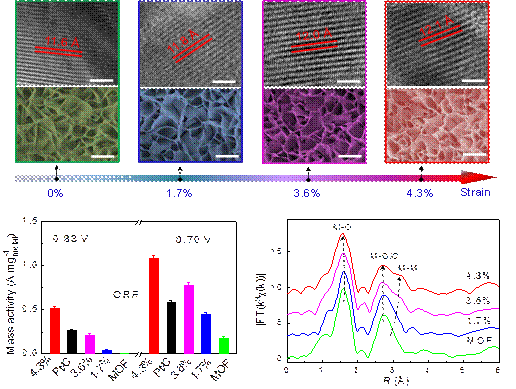| Lattice-Strained NiFe-MOFs for Electrocatalytic Water Oxidation and Oxygen Reduction Reactions |
| From: PublishDate:2020-07-30 Hits: |
Oxygen reduction reaction (ORR) and oxygen evolution reaction (OER) are a pair of reversible electrochemical reactions of fuel cells and metal-air batteries, in which the slow reaction kinetics and low reversibility are the key scientific problems to limit the energy efficiency improvement. Therefore, to meet the urgent need of developing new high-efficiency and stable electrocatalytic materials, a research team from the National Synchrotron Radiation Laboratory (NSRL) of the University of Science and Technology of China (USTC) has performed an in-depth research on the properties and electrocatalytic mechanism of lattice-strained NiFe-MOF electrocatalytic materials, and the related research results were published in Nature Energy on 14 January 2019. By using a "photoinduced lattice strain" strategy, the research group controllably introduced lattice strains into the transition metal-organic framework (TM-MOF) lattice (see Figure 1), reduced the energy barrier of the electrocatalytic reaction by regulating the 3d electronic structure of the active site of TM ions, and obtained a highly efficient bifunctional oxygen electrocatalytic material. The specific mass activity of NiFe-MOF materials with lattice strain for ORR and OER are 500 A gmetal-1 (at 0.83 V potential) and 2000 A gmetal-1 (at 0.30 V overpotential), respectively, 2 orders of magnitude higher than that of NiFe-MOF materials without lattice strain. In addition, the lattice-strained NiFe-MOF material was tested for ORR and OER stability at electrode potential of 0.85 V and 1.45 V, respectively, and the current density attenuation was only 3% after 200 hours, indicating that the lattice-strained NiFe-MOF material has excellent electrochemical stability.
Figure 1. Structure regulation and performance characterization of lattice-strained MOFs, and local atomic structure of lattice-strained NiFe-MOFs obtained by using the 1W1B-XAFS station of Beijing Synchrotron Radiation Facility (BSRF). By using the 1W1B-XAFS station in Beijing Synchrotron Radiation Facility (BSRF), the team obtained various local atomic and electronic structures of the lattice-strained NiFe-MOFs (see Figure 1). Based on the in-depth research on the oxygen electrocatalytic process of the lattice-strained NiFe - MOFs, they firstly observed the oxygen reaction intermediate *OOH appears which directly bonds with Ni4+ activity center in the oxygen catalytic process, along with the increase of Ni valence state, and revealed an efficient 4e- oxygen catalytic reaction mechanism for the lattice-strained NiFe MOF catalytic materials. This study elucidates the microscopic mechanism of efficient energy transfer and transformation of lattice-strained NiFe-MOF materials at the atomic level. In this work, the synchrotron radiation source helped the team to unravel the veil of local microstructure changes of the lattice-strained MOF materials. Liu Qinghua, associate professor at the National Synchrotron Radiation Laboratory of the University of Science and Technology of China, describes their work in this way: "feedback from these micro-local structure test results can guide the optimization of material synthesis conditions and further improve and optimize our material properties and operation stability. The establishment of time-resolved detection technology on brighter synchrotron beams will certainly contribute to further research into the internal mechanisms of energy conversion devices such as fuel cells and provide technical support for the development of commercial energy conversion systems." Article: Weiren Cheng, Xu Zhao, Hui Su, Fumin Tang, Wei Che, Hui Zhang and Qinghua Liu*. Lattice-strained metal–organic-framework arrays for bifunctional oxygen electrocatalysis. Nature Energy, 4, 115–122 (2019). |
|
|
| Chinese
- Metal-free efficient photocatalyst for stable visible water splitting——Top ten major scientific progresses in China in 2015
- The nano-resolution imaging platform was awarded the first rate prize of Beijing Science and Technology in 2014
- Beamline 1W1 of BSRF started to runoperate in the couplingparasitic mode of BEPCII
- Synthesis of High Performance Polymer Materials for Field Effect-Transistors
- Surfactant molecular aggregates in green solvents
- GIXRD has played an important role in the characterization of organic thin-film transistors
Copyright © 2011 - 2012 Beijing Synchrotron Radiation Facility


